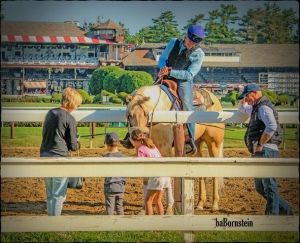News
How Can Racing Grow Its Fan Base
8/15/2022
Looking at an aerial view of the grandstands at Saratoga or Del Mar on
this past Saturday, one would think that racing is the most popular fansport going. Thousands of people watching races and some even
picnicking in the backyard. The truth is that the snippets of major
weekends of racing do not tell the whole story. Certainly, these two
tracks capitalize on “the place to be on a Saturday afternoon” ---
hobnobbing with horsemen and celebrities. But the other 60+ tracks
that hold racing tell a different story. Racing needs new fans. A study
done years ago found that the aging racing fan base was eroding by
about 4% per year.
However, the good news can be found in the amount of money fans
wager. Although racing has fewer fans they are wagering more. Handle
for 2021 exceed the handle in 2020 by $1.286 billion. Can racing keep
this growth up with a declining number of fans? Add the threat of
sports betting erosion of racing fans’ discretionary wagering budgets
and the answer is bleaker.
Tracks across the country have been trying to increase their fan base.
However, limited resources available to tracks curtails their reach into
the public for new fans. Efforts like America’s Best Racing have focused
on a new generation of fans. This is a useful approach, but one that
takes years to mature. Many of us know how long it takes to learn the
intricacies of our sport. The learning curve to be a proficient
handicapper and bettor takes years and a significant loss of revenue at
the window in the process. In the beginning young, new fans lack
knowledge and finances to be profitable for tracks. After a few years
they might be.
This reminds me of a story. A few years ago, we were camping at a
casino RV Park. When we went over for dinner, we met the Marketing
Director. We asked, why so few people were shuttling to the casino
from the RV park to gamble or dine. He answered solemnly. The RV
Park attracts families. Their children will become familiar with our
property so when they are older, they will come to us. “You see,” he
said,” we are marketing for the next generation.” If only racing had that
luxury of time.
Across the world countries are using marketing companies to find and
grow new fans. In Britain that task rests with Racing for Change. Even
there the company has a limited budget to do what Britain wants to
accomplish. Japan is another story.
The racing fans in Japan idolizes their racehorse. The industry has
invested a lot of money and energy in getting fans to know the horses
as the stars of the game. They are “rock-stars” that fans want to follow.
There even have trading cards of horses like baseball has in the United
States. For that culture, the relationship fans have with the horses has
raised the popularity of the sport enormously. According in an article in
Blood-Horse a company, Horse Girl (translated), has developed a
mobile gaming product that excites most fans and made the company
very profitable ---$999 million in sales in 2021.
There appears to be philosophical difference between how Japanese
racing and American racing views the sport. The Japanese approach is
incredibly open and fan friendly. The American approach is more
protective of horses and jockeys. The controls on the fans are strangling
their enthusiasm. For example, only fans with special credentials are
given access to the Paddock or the backside at most tracks. Take one
new fan into the paddock or the Winner’s Circle and you have started a
lifelong fandom journey. Deny that fan the experience and you may
lose her to another sport for life. Gulfstream Park’s exposed walking
ring brings fans closer to the horses, jockeys, and trainers than most
other American tracks. More tracks should follow Gulfstream’s lead.
The message in this article has been known to the racing industry for
years. However, little has been done to fix the problem. Why?
Start at the top. Look at the composition of most Boards of major
tracks. Few, if any, have a fan with a voting right on them. Industry
folks, owners, trainers, and political appointees populate them.
Structurally, this amalgam stifles the conversation about what fans
want and need.
Although ThoroFan believes HISA will help our sport, their Board and
committees suffer from the same narrow view. Granted the enormity
of their initial tasks requires people with the right experience.
Hopefully, when they get established, they will bring fans on their
Board or committees.
Most state Racing Commissions focus more on casinos then on racing
and their appointments reflect that mission. Doc from ThoroFan (Bryan
Langlois) attends the Pennsylvania Committee trying to bring the fans
point of view to their attention. But their committee lacks fan
representatives to fully understand what is presented.
So, if racing in the United States wants to emulate the fandom in Japan,
it would be wise to start at the top. Giving the fans a voice on racing’s
policy making boards.
Latest Archive


